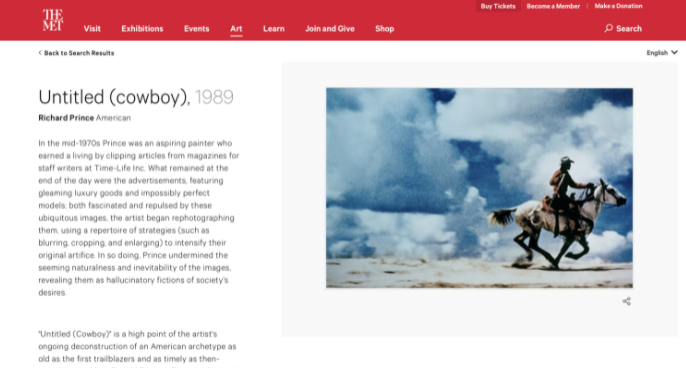June 14, 2019

Collection Highlights on The Metropolitan Museum’s website
Art institutions across New York City are finding new ways to revitalize their archival collections through digital storytelling. When viewing artworks online, observers often wonder about the context surrounding the creation of the work and the artist’s intent. Through the use of digital storytelling these questions are addressed. Not only does digital storytelling engage viewers by providing a backstory to artworks, but it also makes the archival collection more accessible and decipherable to the average person. Approaches to digital storytelling vary between art institutions—this blog post I will cover the different ways three institutions within New York City tackle this new tool.
Earlier this year, the New Museum unveiled their digital multimedia publication, ATLAS , which informs observers through narrative driven essays. The purpose of the publication is to use the museum’s past to help explain its current works. The contextualization of the New Museum’s Digital Archive can enhance viewers’ experiences with current exhibitions. In the first installment of the ATLAS series, an essay written by the New Museum’s Senior Research Fellow Maggie Mustard explores the connections between the New Museum current exhibition Nari Ward: We The People and other works within their collection that utilize found objects. The author also uses past works, unpublished artist statements by Nari Ward, and curatorial essays to contextualize the backstory behind the artist and the exhibition. Adding past exhibitions that focus on found objects–such as Shinique Smith: Bales and Bundles or Chen Zhen: Field of Waste–to the essay provides an analysis of Ward’s individuality and uniqueness in the art medium. Unlike other digital storytelling projects, ATLAS uses the New Museum’s archival materials. The information provided in the publication is a thoughtful analysis of the exhibition by a museum staff member.
In order to provide information to images online, the International Center of Photography (ICP) is in the process of creating the Four Corners Project. According to the ICP website, their goal is to increase authorship of the photographer by providing context that satisfies four key areas: Image Context, Links, Backstory, and Caption, Credit, & Code of Ethics. The Image Context section covers behind the scenes images, before and after shots, and photos taken in the same location. The Links sections includes web links to the artist’s website, links to stories and videos that can further contextualize the image. The Backstory section covers the artist’s statement on the image, the points of view from the subject of the image, witnesses, and journalists. The Caption, Credit, & Code of Ethics provides information on the photographer’s code of ethics, copyright info, and artist caption to the image. A link to each theme is located in one of the four corners of an image. This new system will be embedded into images, so wherever the images end up on the internet, their background and artist will be linked and readily accessible. This also makes it easier for historians to trace all necessary information about each photograph provided by the artist. If this project is successful, this would create a new standard for photographs online. This tool could be helpful to researchers and the casual viewers. My only concern is the question of adding this information to existing photographs—thus far the Four Corners have only been added to newly-posted photographs. If not implemented more widely, millions of photos online will be left in obscurity.
The Metropolitan Museum of Art tackles digital storytelling by cherry-picking artworks for their Collection Highlights. As apart of their online archive, the Collection Highlights are groups of artworks selected by the museum curators from each of their seventeen departments. Exclusive to their Collection Highlights are brief summaries of the artist if the artist is known, an analysis by the curators, and background on the subject of the work. Every artwork in the Met Digital Collections includes information on the Met exhibitions and publications the work was apart of, bibliographic references on the work, notification whether the artwork is currently on display, and recommendations of other works by the artist. The Collection Highlights provides valuable details and context on artworks the average viewer might not know and encourages curiosity into similar works. Browsing through the highlights and their summaries may leave a casual art viewer satisfied, but a researcher might need more information than what is provided. On the other hand, researchers would find the object details and references helpful.
Although I do commend some art institutions’ efforts in presenting their old works with new works in a concise matter, viewers only have access to learning about a few works. The New Museum only makes a new edition of the ATLAS series every time there is a new exhibition, which makes new material infrequent. To address these problems, the New Museum could create similar articles on past exhibitions (possibly spanning from 2014-2018) and connect those to older works. The Met could expand on their efforts to newly uploaded works instead of having additional information exclusive to the Collection Highlights. Despite the problems, the expansion of digital storytelling is exciting. Not only are art institutions engaging with researchers, but also with the general public. Often collections and archives are stored away from the public for years. Digital storytelling helps bring attention to these forgotten resources in an easy-to-understand narrative. In the future, I hope to see digital storytelling used more often as an asset to art institutions and other industries.
Nikisha Roberts
Cite: Roberts, Nikisha. “Digital Storytelling: Reinventing Museum Archives and Collections.” Photography Collections Preservation Project. Accessed November 16, 2021. https://www.photographypreservation.org/blog/2019/6/14/digital-storytelling-reinventing-museum-archives-and-collections.

